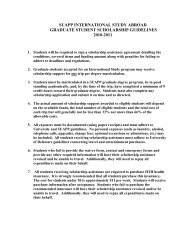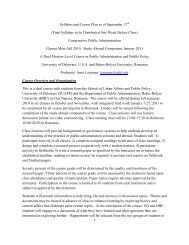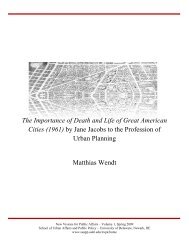New Visions for Public Affairs Volume 1 - School of Public Policy ...
New Visions for Public Affairs Volume 1 - School of Public Policy ...
New Visions for Public Affairs Volume 1 - School of Public Policy ...
You also want an ePaper? Increase the reach of your titles
YUMPU automatically turns print PDFs into web optimized ePapers that Google loves.
Mead, Hilary Bringing Equity Back 8<br />
First, Rebell‟s argument rests on an optimistic<br />
foundation that some would challenge. He sees our<br />
country as guided by a “democratic imperative” which<br />
he defines<br />
“as a period eruption <strong>of</strong> moral fervor that<br />
presses to eliminate the gap between the<br />
real and the ideal by implementing<br />
extensive political re<strong>for</strong>ms that put into<br />
practice America‟s historical egalitarian<br />
ideals” (p.292).<br />
Considering that the power dynamic has turned in<br />
adequacy litigation, with 18 <strong>of</strong> the past 29 cases won by<br />
plaintiffs, Rebell sees this as one <strong>of</strong> those periods <strong>of</strong><br />
moral re<strong>for</strong>m (p.297). Other authors are explicitly<br />
skeptical <strong>of</strong> this narrative <strong>of</strong> progress.<br />
Second, Rebell sees at least some benefits in the current<br />
focus on accountability because it shines a light on<br />
funding and other inequities. He embeds equity within<br />
excellence:<br />
“inherent in the standards movement is<br />
also a powerful equity element, namely its<br />
philosophical premise that all students can<br />
learn at high cognitive levels and that<br />
society has an obligation to provide them<br />
the opportunity to do so” (p.302).<br />
Other authors, notably Lipman (2002), view<br />
accountability very differently; they pierce through the<br />
rhetoric <strong>of</strong> No Child Left Behind and argue “current<br />
policies exacerbate existing inequalities and create new<br />
dynamics <strong>of</strong> inequity” (p. 380). Rebell would respond<br />
that political pressure <strong>for</strong> equity requires test scores that<br />
everyone can understand.<br />
Finally, Rebell again describes a “top-down” and<br />
“bottom-up” movement <strong>for</strong> change. Of all the strategies<br />
that CFE used to engage the public, the key was<br />
requesting to “„level-up‟ the resources in <strong>New</strong> York<br />
City and other under-funded districts by expanding the<br />
pool <strong>of</strong> educational resources, rather than seeking a<br />
„Robin Hood‟ remedy” <strong>of</strong> redistributing funds (Rebell,<br />
2005, p.312). Thus. rich citizens from Great Neck have<br />
nothing to lose by joining this coalition. Although<br />
pragmatic, this strategy raises questions. How <strong>of</strong>ten<br />
can policy decisions be framed in this win-win manner?<br />
(Rebell leaves it ambiguous where these extra resources<br />
will come from.). Does this coalition truly represent<br />
citizens rallying around the cause <strong>of</strong> equity and<br />
grasping its educational benefits <strong>for</strong> all children,<br />
including theirs? Unlike the citizens <strong>of</strong> Brandywine,<br />
these people did not vote or pay, so their commitment is<br />
harder to gauge. The solution proposed by CFE does<br />
not directly address all the structural inequities<br />
discussed in Bringing Equity Back, such as<br />
resegregation. Thus it does not necessarily “bring<br />
equity back” in the way other authors envision. The<br />
Court <strong>of</strong> Appeals‟ ruling was a victory <strong>for</strong> equity, but<br />
Karp (2003) sounds a note <strong>of</strong> caution about the same<br />
case, anticipating an “extended political (and perhaps<br />
additional legal) struggle, in the midst <strong>of</strong> perpetual<br />
budget crises, to turn the court‟s decision into real<br />
educational equity” (p.283). As this book demonstrates<br />
clearly, implementation issues can undermine the best<br />
intentions.<br />
CFE‟s story shows remarkable strategizing on one<br />
level, but it cannot be used as “the answer” <strong>for</strong> re-<br />
<strong>New</strong> <strong>Visions</strong> <strong>for</strong> <strong>Public</strong> <strong>Affairs</strong> – <strong>Volume</strong> 1, Spring 2009<br />
<strong>School</strong> <strong>of</strong> Urban <strong>Affairs</strong> and <strong>Public</strong> <strong>Policy</strong> – University <strong>of</strong> Delaware, <strong>New</strong>ark, DE<br />
www.suapp.udel.edu/nvpa/home







